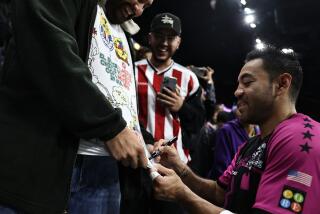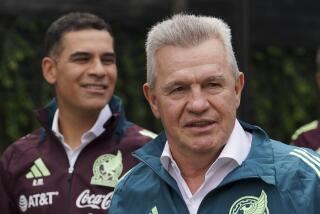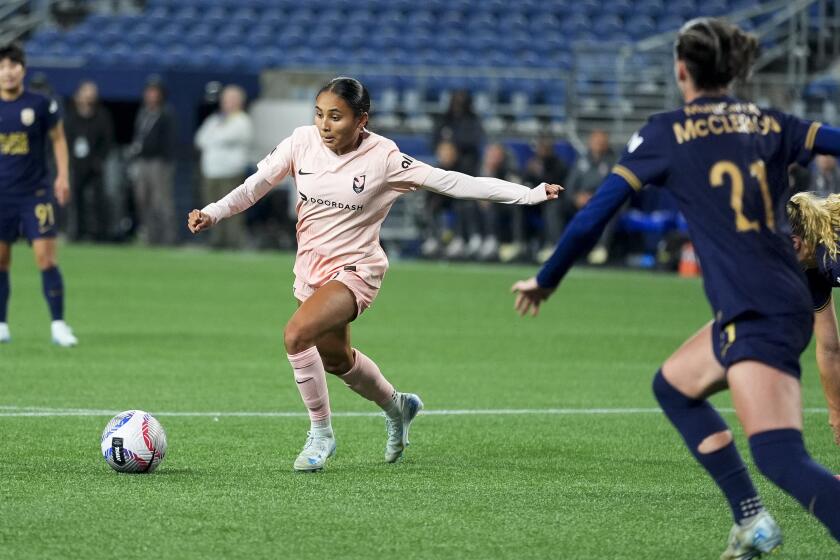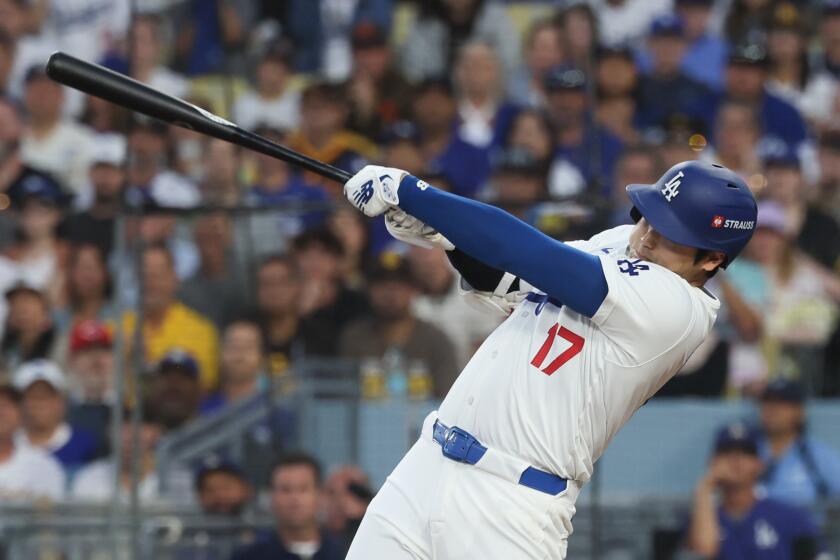Brazil’s Play Draws a Yellow Card for Violation of Style
- Share via
How sad to see that Brazil has succumbed to the win-at-any-cost philosophy pervasive in sports.
True, the Copa America has been won, the Brazilians claiming the championship for the sixth time in the history of the South American tournament.
But the price they paid for winning the event in Paraguay last week was high. Artistry gave way to industry. Flair and flourish were forsaken for fouls and ferocity.
The team’s approach was underlined by Coach Wanderley Luxemburgo, who took over from Mario Zagallo in August in the wake of Brazil’s “failed” World Cup ’98 campaign.
“There are four keys words: Unity, discipline, work and professionalism,” Luxemburgo said in explaining how Brazil had successfully defended the Copa it won in Bolivia in 1997.
Pele would cringe at the sound of them. Whatever happened to individualism, creativity, surprise and delight? Is there no room any more for jogo bonito? Has the beauty all been drained from Pele’s “beautiful game”?
Accounts from Paraguay talked of Brazil’s “tireless marking,” its “hassling” of opponents and, saddest of all, its “systematic fouling.”
The importance, of course, was in winning, especially with the Copa America being the first major tournament for the Brazilians since their 3-0 loss to France in the ’98 World Cup final in Paris a year ago.
Luxemburgo, in fact, dedicated the victory to the players “who were crucified for losing the [World] Cup.”
There seemed almost a desperation to prove that Brazil is inferior to no one, and even Fernando Henrique Cardoso, the country’s president, got in on the act.
“If there is something good about Brazil . . . then that something is soccer,” Cardoso told the players when they were invited to the Alvorada Palace, the presidential residence in Brasilia, last week. “You have shown the world what Brazil is all about.”
No, not really. They have won a tournament, that’s all, defeating Uruguay, 3-0, in an ugly final in which there were 30 fouls in the first 45 minutes.
Had they done so with the passion and precision shown by Brazilian teams of old, it might be worth bragging about. But as it stands, this Brazilian victory is not worth recalling.
Perhaps things will improve. Ronaldo, Rivaldo, Roberto Carlos and Cafu are too good to be wasted playing pragmatic soccer.
“This is the first phase of our project to prepare for the [Sydney 2000] Olympics and the 2002 World Cup,” Luxemburgo said. “We’re happy with the win, but our minds are on the World Cup.”
Perhaps Brazil can regain some of its magic Wednesday when it plays the U.S. in Guadalajara, Mexico, in the FIFA Confederations Cup.
Both teams will no doubt recall their most recent meeting--that 1-0 upset victory by the Kasey Keller-inspired Americans at the Los Angeles Coliseum last year.
DRUGS, WHAT DRUGS?
FIFA, world soccer’s badly splintered governing body, opened itself to a new wave of criticism Friday by making yet another bizarre decision.
Only two weeks after its entire Asian membership walked out of a FIFA Congress in Los Angeles in protest of the allocation of berths in the 2002 World Cup, the Switzerland-based organization got itself mired in a doping controversy.
The biggest of several scandals arising from a disorganized and disappointing Copa America was the failure by two Mexican players--Raul Lara and Paulo Cesar Chavez--to pass drug tests.
Lara and Chavez were suspended from the tournament after testing positive for testosterone/Epitestosterone and Nandrolone, respectively, after a first-round match against Brazil. The pair subsequently were handed a six-month ban by the South American soccer confederation (CSF).
But on Friday, FIFA said it would not uphold the ban since the laboratory that did the testing is not recognized by FIFA or the International Olympic Committee.
FIFA ruled that the players therefore are eligible to play in international competition, including the eight-nation FIFA Confederations Cup that began Saturday in Mexico.
Jose Luis Serrano, Mexico’s team doctor, vehemently had insisted the players were innocent.
They had eaten contaminated food, he said.
The performance-enhancing drugs needed a high degree of specialization to be administered, he said.
The substances are produced naturally by the human body, he said.
Mexico even threatened to boycott the Confederations Cup that it is hosting.
“If the players involved are not absolved before the Confederations’ Cup, the members of this squad will not take part in that event as a sign of protest and a show of unconditional support,” a signed statement from the rest of the team said.
On Friday, FIFA caved in. But that raises even more questions. For instance:
* Was it Mexico’s threat to withdraw--and the financial disaster that would have caused the tournament--that was behind FIFA’s decision?
* Was Paraguay really using an unofficial lab to conduct drug tests, and if so, why?
* Was there a South American plot to foil Mexico from becoming the first non-South American team to win the Copa America?
* What sort of precedent has FIFA set here?
* Will Mexico be using an officially recognized laboratory to process drug tests in the Confederations Cup?
* Will Lara and Chavez be tested again?
The last of this has not been heard.
WOMEN’S GOLD CUP
In the wake of the hugely successful Women’s World Cup, two developments:
* China, which tied the United States in the final and then lost on penalty kicks, has set up a fund to improve living and training conditions for its female players and to expand the number of domestic and international games. One company already has contributed $1.2 million to the fund.
* CONCACAF, which controls soccer in North and Central America and the Caribbean, said it will introduce a new competition, the CONCACAF Women’s Gold Cup, to be played in the summer of 2000.
“This is intended as a stimulus for all female soccer players at all levels throughout the nations and territories of our 38 members,” said Jack Warner, CONCACAF’s president and a FIFA vice president.
IT’S ABOUT TIME
Doug Logan, Major League Soccer’s commissioner, will be in Mexico for the Confederations Cup, acting as head of the delegation for the U.S. team. While there, Logan will meet with Lothar Matthaeus, Germany’s captain, to talk about his possible move to the New York/New Jersey MetroStars.
The 38-year-old Bayern Munich veteran believes it’s a done deal.
“People from the U.S. league and from New York are here,” he told reporters in Guadalajara. “I will take another look at the contract, and if everything is OK, which I think will be the case, I could well sign a contract [effective Jan. 1, 2000] while I’m still here in Mexico.”
Obviously what MLS needs is a grandfather clause--as in: Don’t sign them.
MLS SHAMBLES
It was smart of Logan to admit that MLS made a huge blunder in staging its All-Star game in San Diego last weekend, when an announced crowd of only 23,277 showed up at Qualcomm Stadium.
“The promotion of the game was a bit of a disappointment,” Logan said. “I take full responsibility and I feel that it was ill-advised to go into a neutral site, but we must all learn by our mistakes. . . .
“From this experience we have learned that the All-Star game or MLS Cup probably won’t be [played] at a neutral site [again] for a very long time, if ever.”
LOCAL SCENE
International soccer returns to Los Angeles this week when the national teams of El Salvador and Guatemala, along with Mexican club teams Atlas and Morelia, compete in the Coliseum Cup.
El Salvador plays Guatemala at 7 p.m. Wednesday, with Atlas and Morelia playing at 9. On Saturday, the losers will play in a third-place game at 5 p.m., with the winners meeting for the championship at 7.







